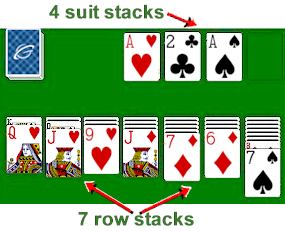Suit stacks to be build are in the upper right corner. The bottom card in each of the 4 suit stacks is an ace. In the
example, 2 of clubs in the second suit stack is already placed
on top of the ace of clubs (ascending order).
The bottom 7 stacks are called row stacks. The cards in the row stacks are in descending order alternating between red
and black. The bottom card in the row stack is the king. In the example, the top open card in the leftmost row stack is the
queen of hearts (red) that is placed on the king of spades (black).
|
